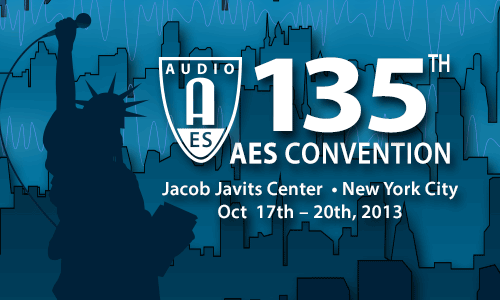
AES New York 2013
Paper Session P9
Friday, October 18, 9:00 am — 11:30 am (Room 1E09)
Paper Session: P9 - Applications in Audio—Part I
Chair:
Sungyoung Kim, Rochester Institute of Technology - Rochester, NY, USA
P9-1 Audio Device Representation, Control, and Monitoring Using SNMP—Andrew Eales, Wellington Institute of Technology - Wellington, New Zealand; Rhodes University - Grahamstown, South Africa; Richard Foss, Rhodes University - Grahamstown, Eastern Cape, South Africa
The Simple Network Management Protocol (SNMP) is widely used to configure and monitor networked devices. The architecture of complex audio devices can be elegantly represented using SNMP tables. Carefully considered table indexing schemes support a logical device model that can be accessed using standard SNMP commands. This paper examines the use of SNMP tables to represent the architecture of audio devices. A representational scheme that uses table indexes to provide direct-access to context-sensitive SNMP data objects is presented. The monitoring of parameter values and the implementation of connection management using SNMP are also discussed.
Convention Paper 8962 (Purchase now)
P9-2 IP Audio in the Real-World; Pitfalls and Practical Solutions Encountered and Implemented when Rolling Out the Redundant Streaming Approach to IP Audio—Kevin Campbell, WorldCast Systems /APT - Belfast, N Ireland; Miami, Florida
This paper will review the development of IP audio links for audio delivery and chiefly look at the possibility of harnessing the flexibility and cost-effectiveness of the public internet for professional audio delivery. We will discuss first the benefits of IP audio when measured against traditional synchronous audio delivery and also the typical problems associated with delivering real-time broadcast audio across packetized networks, specifically in the context of unmanaged IP networks. The paper contains an examination of some techniques employed to overcome these issues with an in-depth look at the redundant packet streaming approach.
Convention Paper 8963 (Purchase now)
P9-3 Implementation of AES-64 Connection Management for Ethernet Audio/Video Bridging Devices—James Dibley, Rhodes University - Grahamstown, South Africa; Richard Foss, Rhodes University - Grahamstown, Eastern Cape, South Africa
AES-64 is a standard for the discovery, enumeration, connection management, and control of multimedia network devices. This paper describes the implementation of an AES-64 protocol stack and control application on devices that support the IEEE Ethernet Audio/Video Bridging standards for streaming multimedia, enabling connection management of network audio streams.
Convention Paper 8964 (Purchase now)
P9-4 Simultaneous Acquisition of a Massive Number of Audio Channels through Optical Means—Gabriel Pablo Nava, NTT Communication Science Laboratories - Kanagawa, Japan; Yutaka Kamamoto, NTT Communication Science Laboratories - Kanagawa, Japan; Takashi G. Sato, NTT Communication Science Laboratories - Kanagawa, Japan; Yoshifumi Shiraki, NTT Communication Science Laboratories - Kanagawa, Japan; Noboru Harada, NTT Communicatin Science Labs - Atsugi-shi, Kanagawa-ken, Japan; Takehiro Moriya, NTT Communicatin Science Labs - Atsugi-shi, Kanagawa-ken, Japan
Sensing sound fields at multiple locations often may become considerably time consuming and expensive when large wired sensor arrays are involved. Although several techniques have been developed to reduce the number of necessary sensors, less work has been reported on efficient techniques to acquire the data from all the sensors. This paper introduces an optical system, based on the concept of visible light communication, which allows the simultaneous acquisition of audio signals from a massive number of channels via arrays of light emitting diodes (LEDs) and a high speed camera. Similar approaches use LEDs to express the sound pressure of steady state fields as a scaled luminous intensity. The proposed sensor units, in contrast, transmit optically the actual digital audio signal sampled by the microphone in real time. Experiments to illustrate two examples of typical applications are presented: a remote acoustic imaging sensor array and a spot beamforming based on the compressive sampling theory. Implementation issues are also addressed to discuss the potential scalability of the system.
Convention Paper 8965 (Purchase now)
P9-5 Blind Microphone Analysis and Stable Tone Phase Analysis for Audio Tampering Detection—Luca Cuccovillo, Fraunhofer Institute for Digital Media Technology IDMT - Ilmenau, Germany; Sebastian Mann, Fraunhofer Institute for Digital Media Technology IDMT - Ilmenau, Germany; Patrick Aichroth, Fraunhofer Institute for Digital Media Technology IDMT - Ilmenau, Germany; Marco Tagliasacchi, Politecnico di Milano - Milan, Italy; Christian Dittmar, Fraunhofer Institute for Digital Media Technology IDMT - Ilmenau, Germany
In this paper we present an audio tampering detection method based on the combination of blind microphone analysis and phase analysis of stable tones, e.g., the electrical network frequency (ENF). The proposed algorithm uses phase analysis to detect segments that might have been tampered. Afterwards, the segments are further analyzed using a feature vector able to discriminate among different microphone types. Using this combined approach, it is possible to achieve a significantly lower false-positive rate and higher reliability as compared to standalone phase analysis.
Convention Paper 8966 (Purchase now)
